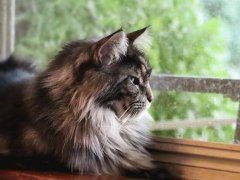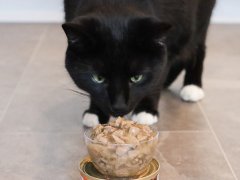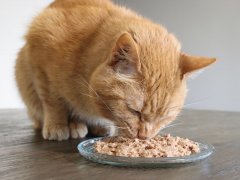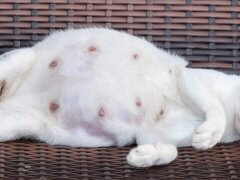
Kirsten McCarthy / Cats.com
Cats are obligate carnivores, requiring an animal-based diet to fulfill their nutritional needs – so why do so many commercial cat food diets contain vegetables? From salmon and potato to lamb and peas, vegetables commonly crop up as an ingredient in cat food.
The bottom line is that cats have no nutritional need for vegetables, but they are often included in pet food as an additional source of nutrition and for perceived health benefits. Let’s have a look at the pros and cons of veggies for our cats.
What’s Good About Including Vegetables in Commercial Cat Food?
Vegetables are strongly associated with health and optimal nutrition in the human world, with the known virtues of veggies including their high levels of vitamins and minerals and being an excellent source of fiber. So what can they do for our cats?
Nutritional Benefit
Although cats can’t digest plant material as well as we omnivores can, it’s likely that they can gain some small potential nutritional goodness from a small amount of high-quality vegetable matter in their diet.
Here are some vegetables that are safe for cats and may give some minor nutritional benefits:
- Broccoli – high in fiber and packed with potassium, calcium, and Vitamins A, C, and E
- Carrots – contain high levels of beta-carotene, which is converted into Vitamin A
- Peas – an excellent source of fiber and plant-based protein
- Sweet potato – rich in antioxidants as well as vitamins and minerals
Taste and Texture
Although most cats are attracted to meaty or fishy tastes and textures, such as chicken or salmon, vegetables can provide additional flavor and textures to commercial diets. Plant material can also add moisture content. Safely prepared vegetables in small quantities can also provide valuable enrichment for cats.
What’s Bad About Including Vegetables in Commercial Cat Food?

Cats are designed to eat a meat-based diet. Kirsten McCarthy / Cats.com
Let’s look at the other side of the coin – what are the negatives of pet food manufacturers using vegetables in your cat’s diet?
Unnecessary for a Cat’s Nutritional Needs
As obligate carnivores, cats require a meat-based diet, which can provide all the nutrients that they require. There is absolutely no requirement nutritionally for a cat to eat vegetables at all, and therefore their presence in commercial cat food is unneeded.
Cheap Filler
As veggies are unnecessary for cats, there are concerns that commercial feline diets using large amounts of vegetable matter are using this as a cheap way to bulk out the food, rather than using the more expensive animal proteins. This is a cost-cutting exercise that may actually be harmful, as cats find plant material more difficult to digest, and may therefore struggle to absorb the nutrients that they need from a diet high in vegetables.
What To Consider When Choosing a Cat Food With Vegetables

Not all fruits and vegetables are safe for cats to eat. Kirsten McCarthy / Cats.com
Many commercial cat foods contain vegetable ingredients, so if you spot spinach or pumpkin alongside the turkey or tuna, there’s no need to be particularly alarmed. Many vegetables are perfectly safe for cats. However, as they are of dubious nutritional benefit, there are a couple of considerations to take into account when looking at the ingredients of your chosen cat food brand.
Emma Passman, a pet nutritionist based in the UK, says “Cats are obligate carnivores, so they require a diet primarily based on animal protein to meet their nutritional needs. While small amounts of certain vegetables can offer fibre and micronutrients, their inclusion should be minimal and carefully balanced. Ideally, the key is ensuring that vegetables, if included, serve a functional role rather than acting as unnecessary fillers.”
Check the Quantity
Small amounts of plant matter are fine in cat food. Large amounts are not. This may seem a simple rule, but as cats are carnivores, they really do need a diet based on meat or fish (which can include meat by-products) with plant matter kept to a minimum. Always check pet food labels, paying particular attention to the first few ingredients that will make up the bulk of the diet.
Cats should be fed a diet that is nutritionally balanced for their needs. The Association of American Feed Control Officials (AAFCO) provides guidance on suitable diets including their composition of major nutrient groups such as protein.
Keep It Safe
There are many fruits and vegetables which are safe for cats to consume in small quantities. However, there are some that can be extremely toxic, such as onions, chives, grapes, and garlic. Introducing new foods also comes with the risk of discovering food allergies, so novel foods should always be fed in small quantities to check for any reactions.
Consult Your Veterinarian
If you’re considering a dietary change for your pet, always discuss this with your vet. Diet changes should be made gradually and with close concern for the cat’s nutritional and health needs. Commercial cat foods vary in quality as well as price, so always seek advice from a professional if you are concerned about your cat’s diet.







